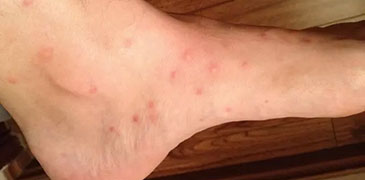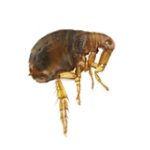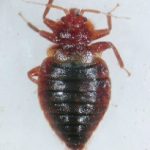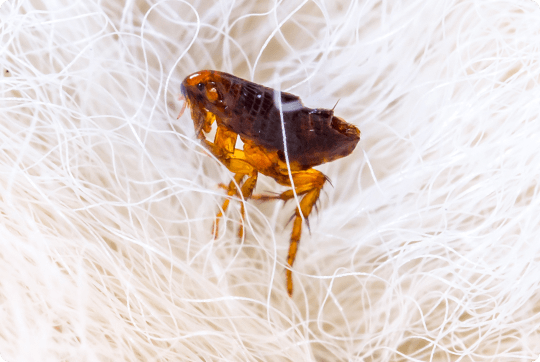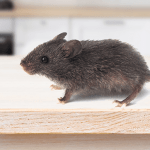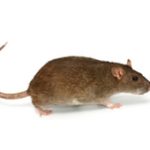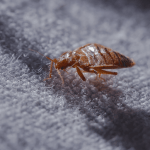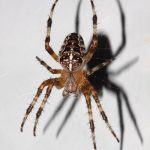How to tell if you have fleas in your home?
What can be worse than waking up in the middle of the night with annoying itchiness? Then, you remember how your pet was scratching hard the previous day. So, this might be a sign of a flea infestation. In this article, you will learn how to identify if your home is really infested by the nasty little bloodsuckers and how to eliminate them quickly.
What does a flea look like to the human eye? How big is a flea?
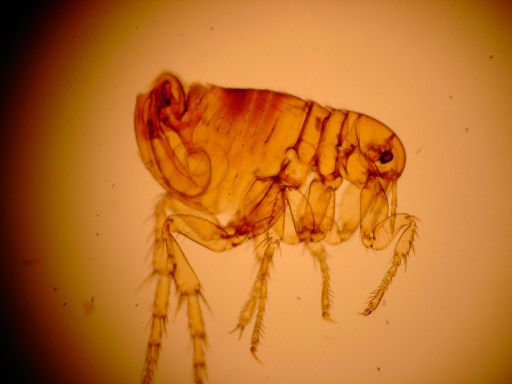
Usually, fleas are visible to the naked eye. They are brown, reddish-brown or black coloured, wingless and have flat bodies. Fleas have 6 legs, which are adapted for jumping. They are very fast and have the ability to jump as high as 30cm. For that reason, you can barely spot them.
Fleas are between 1.5mm and up to 4mm in length. Females are bigger than males, reaching up to 2.5mm in length, whereas the latter can be less than 1mm. For comparison, a black pepper grain has around 5mm diameter, or the head of the ballpoint pins is 4mm in length. So, now you understand how difficult can be to detect these parasites.
Image by: Michael Wunderli / License: CC BY 2.0
Does one flea mean infestation?
Well, if you’ve spotted only one flea, for example on your socks, this is not considered an infestation. Most probably, the vermin attached to your clothes, while you were outside. Only one flea is not enough to infest your house, because it needs both female and male fleas so they can reproduce and lay eggs. So, if you have seen no fleas for a long time since then, you shouldn’t be worried that much. On the other hand, if you’ve detected more than one, you should check if you’re dealing with fleas!
Signs of a flea infestation in home
There are several sure signs that your house is infested by annoying critters. Undoubtedly, fleas are a common problem for pet owners, but you can still be invaded by them even if you don’t have a dog or a cat at home. Check which are the most frequent signs of fleas:
Excessive scratching
Recently, you’ve noticed your dog or cat scratched more than usual? This is usually the foremost sign of your pet being already a host to these vermins. As fleas are crawling and sucking blood, your pets will also lick or bite themselves constantly. So, keep an eye on any uncommon behaviour of your beloved buddy.
Black or white flecks
If you’ve found strange white, brown or black flecks on your pet’s body or on their bedding, this might be another clear sign of a flea infestation. The white ones are flea eggs and the darker ones are known as flea dirt.
Loss of fur
This can be a concerning indicator of a flea presence. Usually, flea bites cause a reaction to the pet’s skin. The allergic reaction is also known as alopecia or hair loss. In such cases, you should take immediate action and consult with a vet for proper flea treatment.
Pale gums
Another way to know if fleas have infested your pets is by checking if they have pale gums. They are a symptom of anemia, due to the fact that fleas extract so much blood that the amount of new red blood cells produced is not sufficient. We strongly recommend visiting a vet ASAP.
Flea bites
Another signal for a flea infestation is when not only your pets but also you become a victim of the flea bites. They can be felt like a small sting and then, the bitten spot turns into a red bruise on your skin. The bitten area will be really itchy and irritating and often can be confused with a mosquito bite. Still, mosquitos are seasonal insects, so you should try to determine the source of the bite. Most commonly, fleas will bite you around the ankles. As the insects usually hide in your carpet, your feet and ankles are the first parts of your body that the fleas can reach to suck blood from.
You see them hopping around
Well, if you’ve spotted the jumpers every now and then, this should ring a bell that you have a flea problem. Remember that you don’t need to be a pet owner to have a flea infestation in your house, as the parasites may jump on you while you’re strolling in the nearest park.
Read more:
Little-Known Signs Of Cat Fleas to Help You Identify a Flea Infestation
What is the First Thing You Should Do If You See Signs of Pest Infestation
How do I know if my dog has fleas?
Where do fleas live in the house?
In short, fleas can be found anywhere around us, in your garden or on your carpets. Fleas prefer shady places, which are humid and dusty. But there are several areas that you should inspect if you suspect fleas in your house or on your pets.
Where do fleas live on cats?
According to a study published by Flea Science, most commonly, fleas live around the head and neck of a cat, as well as on its back and belly. The tail and legs are the areas, the least preferred by the fleas.
Where do fleas live on dogs?
Most likely, the areas, where fleas can be found on your dog, are those around its lower back. You can also check the chest, its belly and the legs. Unlike cats, the neck and head of your dog are less likely to be affected by the pesky vermins.
Other places to look for
Your pet is not the only place, where the fleas could hide. You should also take a check the following places that might be infested by these parasites:
- Carpets and rugs
- Upholstered Furniture
- Pet’s bedding
- Garden (tree barks, around decks, bushes and leaf debris)
All of the above-mentioned places are most likely to be infested by fleas as they provide the perfect conditions for their life cycle.
Can fleas live on humans?
Well, fleas don’t live on humans, since they are not covered in fur, where the pests can hide, but this doesn’t mean they won’t feed on your blood, given the chance. For instance, fleas can be transferred from one place to another by hitchhiking on your clothes, socks, shoes or even your hair.
Can fleas live without a host?
Like any other creature that needs a source of food, fleas couldn’t be able to survive for a long time without a host, as they feed on blood. So, without it, fleas can live approximately 100 days. In addition, female fleas are not able to lay eggs without a blood meal. Of course, there are many other conditions, which affect their life cycle.
Can I Get Fleas if I Don’t Have Pets?
Yes, of course! You don’t have to own a pet to get a flea infestation. For instance, you can go outside for a walk one day and unknowingly bring fleas back to your home, because they took a ride on your clothes. As we’ve mentioned above, they can hide anywhere in the environment, especially where animals live or pets are taken for a stroll. For example, squirrels, rats and mice can also become the perfect hosts for fleas. And as we know, the rodents can inhabit the nearest park, roam the streets or invade our homes.
How to get rid of flea infestation?
Now, if you are certain that you are dealing with an infestation, it’s time to take some measures to get rid of the fleas.
Flea home remedies
- Salt: It’s used as a dehydrating solution, which will help you get rid of the flea eggs. Sprinkle some salt on your carpet and leave it for a couple of days. After that, clean the carpets with a vacuum cleaner.
- Dish soap and water: Leave a bowl with water on the carpet or rug. Add the dish soap and put a desk lamp above the bowl. This method will attract adult fleas, which will jump into the bowl and the dish soap should kill them.
- Baking soda: Place some baking soda on the carpets and scrub it into the carpet. Then, again, use a hoover to remove it.
There are many more homemade solutions that can be used as an anti-flea treatment, but note that they might not help you against an extensive flea infestation!
Keep your home as clean as possible
As fleas love dusty spots, you should always keep your house clean and sanitised. Make sure that you vacuum regularly all wooden floors, carpets, rugs, draperies and your upholstered furniture! This method is one of the most efficient, as you can suck not only the adult fleas but also their eggs and larvae, as well. If you are a pet owner, wash the pet’s bedding every week. And of course, treat your dog or cat regularly against fleas and ticks and put a flea collar on your pet, as well.
Professional flea treatment
Indeed, this is the most efficient way to get rid of fleas. The professional flea treatment involves the use of high-quality equipment and professional insecticidal products that will de-flea your house effectively and with long-lasting results. Well, if you have pets, professional pest control will not guarantee you 100% a flea-free house, as pets get infested with these creatures. For that reason, we recommend you visit a vet who will prescribe the right flea treatment for your dog or cat.
Still not sure if you have flea infestation?
We provide helpful information according to the expertise and knowledge of the pest technicians. However, we don’t offer any medical advice.



